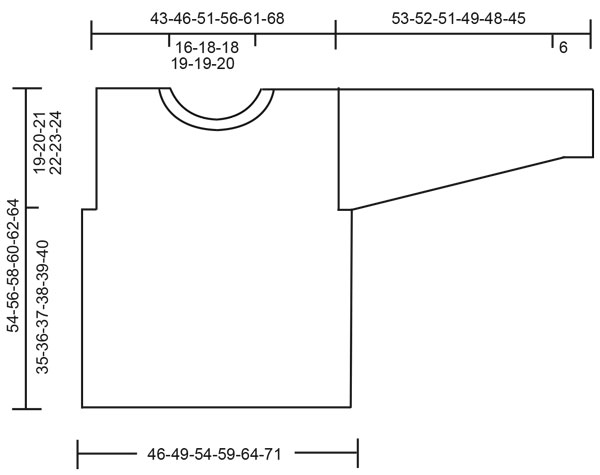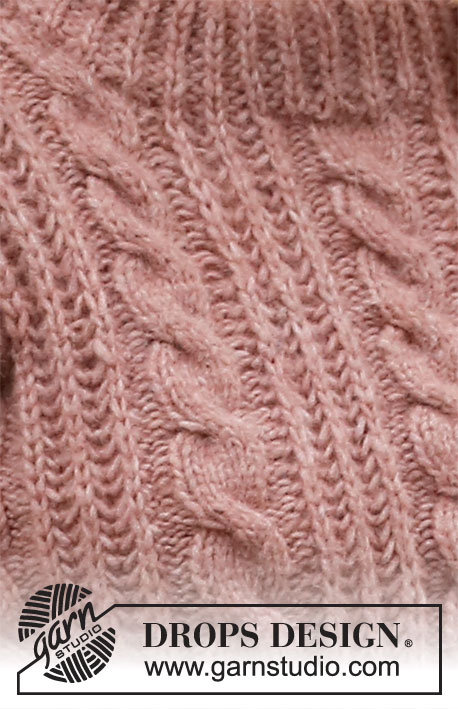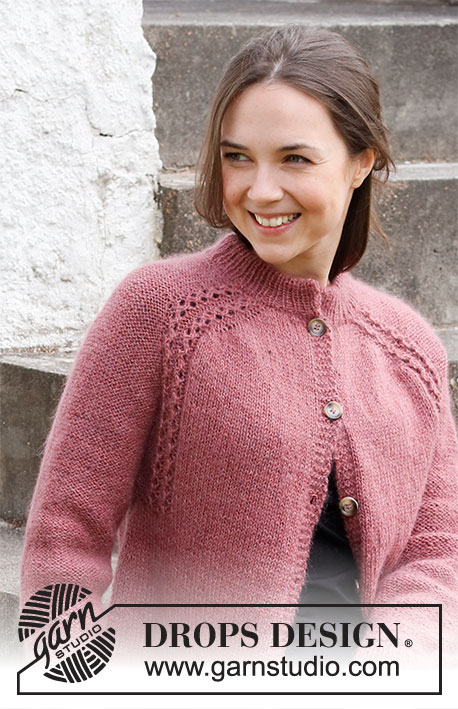Comments / Questions (6)
![]() Agnieszka Janicka wrote:
Agnieszka Janicka wrote:
Czy Zamykanie 5 oczek przy rozdzielaniu przodu i tylko, wychodzi na srodku wzoru A.1a?
10.08.2022 - 10:21DROPS Design answered:
Witaj Agnieszko, dokładnie tak jest. Miłej pracy!
10.08.2022 - 21:42
![]() Hanneke wrote:
Hanneke wrote:
Als ik naar de foto kijk zie ik langs de mouwaanzet slechts één patentsteek. Als ik dan ga rekenen kom ik op maximaal 74 steken uit ( 5x A2 + 4x A3 + aan weerszijde A4a). Dit klopt niet met de beschrijving. Dan zouden er met 84 steken op het voorpand nl 7 steken in patentsteek aan elke kant moeten zijn. Klopt de beschrijving dan wel?
13.11.2021 - 13:42
![]() Ursula wrote:
Ursula wrote:
Ich stricke gerade an dem Model und weiss nicht wo ich die Laenge des Pullovers messen soll. Das Patentmuster ist um 2cm kuerzer als das Zopfmuster, wo messe ich die richtige Laenge? Vielen Dank im vorraus fuer Ihre Antwort, Ursula
07.05.2021 - 09:06DROPS Design answered:
Liebe Ursula, messen Sie von der Anschlagskante, dh die längere Länge. Viel Spaß beim stricken!
07.05.2021 - 12:49
![]() Kristina Silfver wrote:
Kristina Silfver wrote:
Hej, Nu har jag stickat ett varv rätt och sen första varvet enligt mönstret (med en hel massa omslag , som ju blir en maska) därför består ju andra varvet av mönsterstickningen väldigt många fler maskor än vad första varvet gör. Eller hur? Så när det står "sticka A.1 över de sista 12 maskorna (eftersom jag stickar storlek small) så är det ju inte 12 maskor kvar utan 42 maskor. Vad gör jag för fel?
18.02.2021 - 16:53
![]() Susanne wrote:
Susanne wrote:
Als geübte Strickerin,habe ich mich mit der Anleitung und dem Mustersatz A1 / A3 ziemlich schwer getan. Warum schreiben sie nicht gleich Vollpatent stricken. Die Anleitung ist sehr unverständlich obwohl sie einfach ist.
05.01.2021 - 20:27
![]() Evelyne wrote:
Evelyne wrote:
Dans les rangs pairs quand on tricote en rond, comment doit on tricoter la derniere maille de A3 avant de commencer A2? Si on termine par glisser une maille à l'envers, le fil est tiré devant le travail et ca ne parait pas tres joli. Merci de bien vouloir m'aider à tricoter ce joli pull.
28.08.2020 - 00:22DROPS Design answered:
Bonjour Evelyne, A.3 se tricote sur 5 mailles et la dernière maille est "1 jeté, glissez 1 m à l'env" - si vous devez tricotez ensuite une maille envers, veillez à ce que le fil forme bien un jeté au-dessus de la maille glissée avant de le remettre devant et tricoter votre maille envers. Si la dernière maille de A.3 vous paraît trop lâche, serrez davantage votre fil au moment de tricoter cette maille avant A.2. Vous pouvez vous entraîner sur un échantillon et laver votre échantillon, bien souvent les mailles se mettent ensuite en place après le premier lavage (qui peut servir de blocage). Bon tricot!
28.08.2020 - 08:20
Rippling Roses#ripplingrosessweater |
|||||||||||||||||||
 |
 |
||||||||||||||||||
Knitted jumper with cables and English rib stitches in DROPS Air. Sizes S – XXXL.
DROPS 218-15 |
|||||||||||||||||||
|
------------------------------------------------------- EXPLANATIONS FOR THE PATTERN: ------------------------------------------------------- RIDGE/GARTER STITCH (worked back and forth): Knit all rows. 1 ridge in height = Knit 2 rows. PATTERN: See diagrams A.1 to A.4. INCREASE TIP (for sleeves): Increase 1 stitch on each side of the marker thread as follows: Work until there is 1 stitch left before the marker thread, 1 yarn over, work 2 stitches as before (marker thread sits between these 2 stitches), 1 yarn over. On the next round work the yarn overs twisted to avoid holes. ------------------------------------------------------- START THE PIECE HERE: ------------------------------------------------------- JUMPER – SHORT OVERVIEW OF THE PIECE: The jumper is worked in the round with circular needle bottom up, as far as the armholes, the piece is then divided and each section finished separately. The sleeves are worked in the round with short circular needle/double pointed needles. The neck is worked to finish. BODY: Cast on 178-186-202-230-246-282 stitches with circular needle size 5.5 mm and Air. Knit 1 round then work pattern as follows: A.1 over the first 7-9-13-5-9-3 stitches, * A.2 (= 10 stitches), A.3 (= 5 stitches) *, work from *-* 4-4-4-6-6-8 times, A.2, work A.1 over the next 19-23-31-15-23-11 stitches, * A.2 (= 10 stitches), A.3 (= 5 stitches) *, work from *-* 4-4-4-6-6-8 times, A.2, A.1 over the last 12-14-18-10-14-8 stitches. Continue this pattern; when the first 2 rows in A.1 and A.3 have been worked, repeat A.1a and A.3a onwards. Work until the piece measures 35-36-37-38-39-40 cm from the cast-on edge. REMEMBER THE KNITTING TENSION! The next round is worked as follows: Work the first 84-88-96-110-118-136 stitches, cast off the next 5-5-5-5-5-5 stitches, work the next 84-88-96-110-118-136 stitches and cast off the last 5-5-5-5-5-5 stitches. Front and back pieces are finished separately, back and forth. FRONT PIECE: = 84-88-96-110-118-136 stitches. Continue with A.1, A.2 and A.3 as before, but with 1 edge stitch in GARTER STITCH on each side – read description above. Continue working until the piece measures 46-48-50-52-54-56 cm. Place the middle 16-18-18-20-20-22 stitches on a thread for the neck (make sure stitches are worked from wrong side before placed on thread) and each shoulder is finished separately. Cast off at the beginning of each row from the neck as follows: 2 stitches 1 time and 1 stitch 3 times = 29-30-34-40-44-52 stitches left on each shoulder. Cast off when the piece measures 54-56-58-60-62-64 cm (= 19-20-21-22-23-24 cm from the bottom of the armhole). BACK PIECE: = 84-88-96-110-118-136 stitches. Continue with A.1, A.2 and A.3 as before, but with 1 edge stitch in garter stitch on each side. Continue working until the piece measures 52-54-56-58-60-62 cm. Place the middle 24-26-26-28-28-30 stitches on a thread for the neck (make sure stitches are worked from wrong side before placed on thread) and each shoulder is finished separately. On the next row cast off 1 stitch towards the neck = 29-30-34-40-44-52 stitches left on each shoulder. Cast off when the piece measures 54-56-58-60-62-64 cm (= 19-20-21-22-23-24 cm from the bottom of the armhole). SLEEVE: Cast on 50-52-54-56-58-60 stitches with double pointed needles size 4.5 mm. Knit 1 round, then work A.4 over all stitches. When the first 2 rounds in A.4 have been worked, repeat A.4a onwards. Continue this pattern until the piece measures 6 cm. Knit 1 round where you decrease 6 stitches evenly spaced = 44-46-48-50-52-54 stitches. Change to double pointed needles size 5.5 mm. Knit 1 round. Insert a marker thread at the beginning of the round (= mid under the sleeve). Work stocking stitch. When the piece measures 8 cm from the cast-on edge, begin to increase mid under the sleeve – read INCREASE TIP. Increase every 5½-5-4½-4-3½-3 cm a total of 8-9-10-10-11-12 times = 60-64-68-70-74-78 stitches. Continue working until the sleeve measures 53-52-51-49-48-45 cm. Cast off. Work the other sleeve in the same way. ASSEMBLY: Sew the shoulder seams. NECK: Using short circular needle size 4.5 mm pick up 64 to 84 stitches around the neck (including the stitches from the threads). Make sure the number of stitches is divisible by 2. Work A.4a over all stitches, but on first round the picked-up stitches are worked without yarn overs, AT THE SAME TIME decrease 1 stitch in cable in A.2 from thread by knitting 3rd and 4th stitch from cable together. NOTE! A.4a should match the stitches from the threads so the English rib pattern continues up the neck. If necessary adjust the number of stitches between the threads! Continue this pattern until the neck measures 10 cm. Cast off with knit. ASSEMBLY: Fold the neck double to the wrong side and sew the cast-off edge to the round with the knitted up stitches; the neck is now approx. 5 cm. Sew in the sleeves, inside the 1 edge stitch on the front/back pieces. |
|||||||||||||||||||
Diagram explanations |
|||||||||||||||||||
|
|||||||||||||||||||

|
|||||||||||||||||||

|
|||||||||||||||||||
Have you finished this pattern?Tag your pictures with #dropspattern #ripplingrosessweater or submit them to the #dropsfan gallery. Do you need help with this pattern?You'll find 33 tutorial videos, a Comments/Questions area and more by visiting the pattern on garnstudio.com. © 1982-2025 DROPS Design A/S. We reserve all rights. This document, including all its sub-sections, has copyrights. Read more about what you can do with our patterns at the bottom of each pattern on our site. |
|||||||||||||||||||




















































































Post a comment to pattern DROPS 218-15
We would love to hear what you have to say about this pattern!
If you want to leave a question, please make sure you select the correct category in the form below, to speed up the answering process. Required fields are marked *.